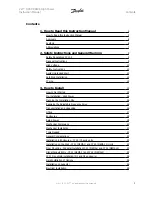
OPERATION
Page
74
Copyright
Trace Engineering Company, Inc.
5916 - 195th Street N. E.
Arlington, WA 98223
Telephone: 360/435-8826
Fax: 360/435-2229
www.traceengineering.com
SW Series Inverter/Charger
Part No. 2031-5
Rev. B: Sept 1, 1999
GEN CONTROL RELAYS
WARNING: All circuits connecting the auto generator control system MUST be protected with
fuses rated at 5 amps or less. The warranty does not cover damage to these relays. Fuses should
be located as close as possible to the point of connection to the larger conductors providing power from
the battery. A fuse must be used, even if the circuit is providing only a “dry contact” or “ground”
connection - it will prevent damage if the connection is miswired or if the cable connecting the inverter to
the generator is damaged.
The generator control relays are not intended to directly control the starter motor or operate the ignition
system - rather they are used to send a signal to operate the coil of another higher amperage device
which does the actual switching of power. For location and wiring information on the Gen Control Relays,
see AUXILIARY AND GENERATOR CONTROL RELAY on page 14.
The SW Series Inverter/Charger provides two relays, labeled RY7 and RY8, to allow starting of many
types of generators. Two LED indicators provide status indications whether RY7 or RY8 have been
energized.
The relay labeled RY7 is used to provide either a STOP signal or a RUN signal. It can also be used to
provide a GLOW signal on diesel generators with glowplugs. The relay labeled RY8 is used to provide a
crank signal for the starter of the generator engine. It is not used on two-wire type (auto cranking)
generators. The COM (common) terminals of the relays are separated and both the N.O. (normally open)
and N.C. (normally closed) contacts of the relays are provided.
It is much easier to make the connections to the generator if a remote control terminal or connector is
available on the generator. This sometimes requires that the generator optional remote control be
purchased. This also allows examination of how the generator remote control works - which is what the
inverter’s generator control system in the inverter must duplicate.
Connection of the GEN CONTROL RELAYS to the generator remote control also eliminates the need to
modify the generator and violate the warranty of the generator.
You should also add a switch to allow disabling of the automatic generator control system at the generator
to allow local control of the generator, preventing starting while servicing, etc. Many generators include this
switch with the optional remote control.
GENERATOR STARTING SCENARIOS
The generator can be set to start based on the four following scenarios:
AUTOMATICALLY
(1) AC Current: The generator starts whenever the current travelling through the inverter to the AC
loads remains above the LOAD START AMPS AC setting for the selected LOAD START DELAY
MIN period. The current can be monitored by the LOAD AMPS AC menu item under the METERS
menu. The generator will start, unless the timer is in the “quiet time” period, at which time it will only
start if the READ LBCO 30 SEC START VDC setting is reached. Whenever the generator starts
automatically, based on load amps, it will shut off once the load current drops below the LOAD
START AMPS value for the selected LOAD STOP DELAY MIN period.
(2) Battery Voltage: The generator starts whenever the battery voltage reaches one of the four
adjustable low battery voltage levels for the selected delay periods (24 hours, 2 hours, 15 minutes, or
30 seconds). The low battery voltage levels are set under the GEN AUTO START SETUP. Actual
battery voltage can be monitored from the BATTERY ACTUAL VOLTS DC menu item under the
METERS menu. The generator will start, unless the timer is in the “quiet time” period, at which time it
will only start if the SET LOW BATTERY CUTOUT VDC or READ LBCO 30 SEC START VDC
setting is reached. Whenever the generator starts automatically, based on low battery voltage it will
shut off once the BULK and ABSORPTION stages of the battery charging have completed, thus
fully recharging the batteries.
Summary of Contents for SW II - REV 4.01
Page 151: ......
















































